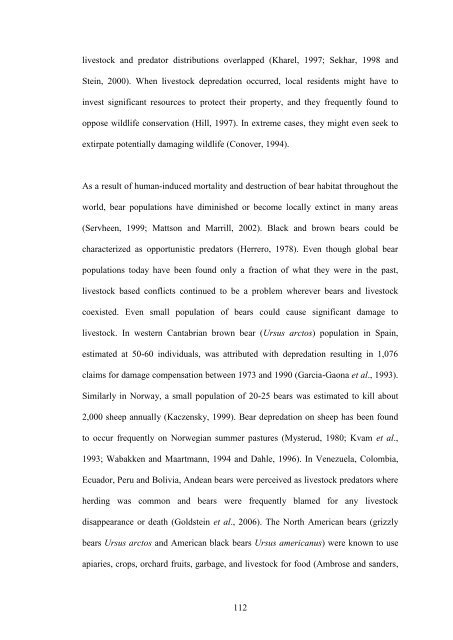Certificate - Etheses - Saurashtra University
Certificate - Etheses - Saurashtra University
Certificate - Etheses - Saurashtra University
Create successful ePaper yourself
Turn your PDF publications into a flip-book with our unique Google optimized e-Paper software.
livestock and predator distributions overlapped (Kharel, 1997; Sekhar, 1998 and<br />
Stein, 2000). When livestock depredation occurred, local residents might have to<br />
invest significant resources to protect their property, and they frequently found to<br />
oppose wildlife conservation (Hill, 1997). In extreme cases, they might even seek to<br />
extirpate potentially damaging wildlife (Conover, 1994).<br />
As a result of human-induced mortality and destruction of bear habitat throughout the<br />
world, bear populations have diminished or become locally extinct in many areas<br />
(Servheen, 1999; Mattson and Marrill, 2002). Black and brown bears could be<br />
characterized as opportunistic predators (Herrero, 1978). Even though global bear<br />
populations today have been found only a fraction of what they were in the past,<br />
livestock based conflicts continued to be a problem wherever bears and livestock<br />
coexisted. Even small population of bears could cause significant damage to<br />
livestock. In western Cantabrian brown bear (Ursus arctos) population in Spain,<br />
estimated at 50-60 individuals, was attributed with depredation resulting in 1,076<br />
claims for damage compensation between 1973 and 1990 (Garcia-Gaona et al., 1993).<br />
Similarly in Norway, a small population of 20-25 bears was estimated to kill about<br />
2,000 sheep annually (Kaczensky, 1999). Bear depredation on sheep has been found<br />
to occur frequently on Norwegian summer pastures (Mysterud, 1980; Kvam et al.,<br />
1993; Wabakken and Maartmann, 1994 and Dahle, 1996). In Venezuela, Colombia,<br />
Ecuador, Peru and Bolivia, Andean bears were perceived as livestock predators where<br />
herding was common and bears were frequently blamed for any livestock<br />
disappearance or death (Goldstein et al., 2006). The North American bears (grizzly<br />
bears Ursus arctos and American black bears Ursus americanus) were known to use<br />
apiaries, crops, orchard fruits, garbage, and livestock for food (Ambrose and sanders,<br />
112

















